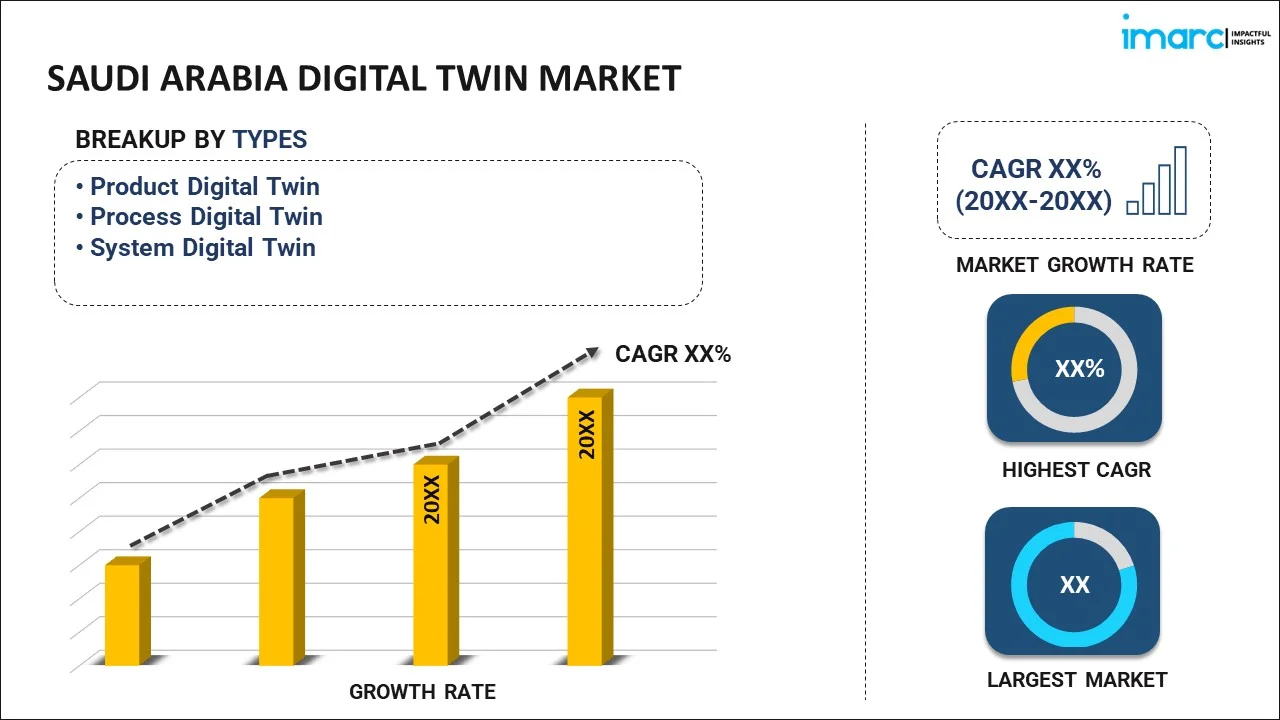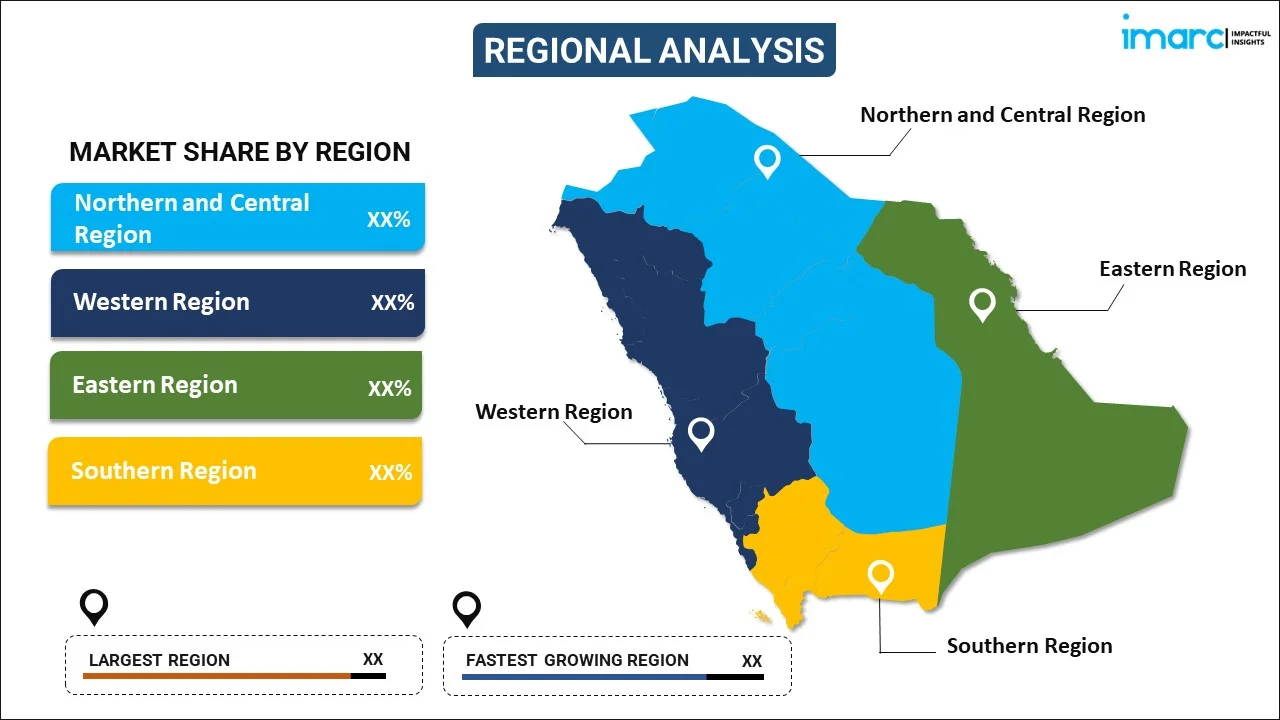
Saudi Arabia Digital Twin Market Report by Type (Product Digital Twin, Process Digital Twin, System Digital Twin), Technology (IoT and IIoT, Blockchain, Artificial Intelligence and Machine Learning, Augmented Reality, Virtual Reality and Mixed Reality, Big Data Analytics, 5G), End Use (Aerospace and Defense, Automotive and Transportation, Healthcare, Energy and Utilities, Oil and Gas, Agriculture, Residential and Commercial, Retail and Consumer Goods, Telecommunication, and Others), and Region 2025-2033
Market Overview:
Saudi Arabia digital twin market size reached USD 217.2 Million in 2024. Looking forward, IMARC Group expects the market to reach USD 15,749.6 Million by 2033, exhibiting a growth rate (CAGR) of 61% during 2025-2033. The increasing technologies that help to analyze and interpret data generated by digital twins, providing valuable insights and predictions, are driving the market.
|
Report Attribute
|
Key Statistics
|
|---|---|
|
Base Year
|
2024 |
|
Forecast Years
|
2025-2033
|
|
Historical Years
|
2019-2024
|
| Market Size in 2024 | USD 217.2 Million |
| Market Forecast in 2033 | USD 15,749.6 Million |
| Market Growth Rate (2025-2033) | 61% |
A digital twin is a virtual representation of a physical object, system, or process, created using real-time data and advanced technologies like sensors, IoT devices, and simulations. It serves as a dynamic and interactive counterpart to its physical counterpart, enabling real-time monitoring, analysis, and optimization. Digital twins facilitate a deeper understanding of the physical entity's behavior, performance, and condition by continuously collecting and processing data. This technology finds applications across various industries, including manufacturing, healthcare, and urban planning. By mimicking the physical world in a digital space, digital twins empower organizations to make informed decisions, enhance efficiency, predict maintenance needs, and simulate scenarios for improved problem-solving. The concept has gained traction as a powerful tool for innovation, allowing businesses to gain insights, improve processes, and optimize outcomes in a rapidly evolving digital landscape.
Saudi Arabia Digital Twin Market Trends:
The digital twin market in Saudi Arabia is experiencing unprecedented growth, primarily driven by several key factors. Firstly, the increasing adoption of IoT technologies has played a pivotal role in propelling the demand for digital twins. As organizations strive for greater connectivity and data-driven insights, the seamless integration of IoT devices with digital twins has become imperative. Furthermore, the surge in demand for predictive maintenance solutions has emerged as a significant driver. Digital twins enable organizations to create virtual replicas of physical assets, facilitating real-time monitoring and analysis. This predictive capability not only enhances operational efficiency but also minimizes downtime, a crucial factor for industries reliant on continuous production. In addition, the advent of advanced technologies such as artificial intelligence (AI) and machine learning (ML) has further fueled the digital twin market. The synergy between digital twins and AI/ML algorithms empowers businesses to derive actionable insights, optimize processes, and make informed decisions. Moreover, the growing emphasis on sustainability and environmental consciousness has driven industries to leverage digital twins for resource optimization. By simulating and analyzing various scenarios, organizations can achieve greater energy efficiency and reduce their ecological footprint. In conclusion, the digital twin market in Saudi Arabia is thriving due to the confluence of IoT integration, predictive maintenance needs, advancements in AI/ML, and a heightened focus on sustainable practices, collectively shaping a dynamic and innovative landscape.
Saudi Arabia Digital Twin Market Segmentation:
IMARC Group provides an analysis of the key trends in each segment of the market, along with forecasts at the country level for 2025-2033. Our report has categorized the market based on type, technology, and end use.
Type Insights:

- Product Digital Twin
- Process Digital Twin
- System Digital Twin
The report has provided a detailed breakup and analysis of the market based on the type. This includes product digital twin, process digital twin, and system digital twin.
Technology Insights:
- IoT and IIoT
- Blockchain
- Artificial Intelligence and Machine Learning
- Augmented Reality, Virtual Reality and Mixed Reality
- Big Data Analytics
- 5G
A detailed breakup and analysis of the market based on the technology have also been provided in the report. This includes IoT and IIoT, blockchain, artificial intelligence and machine learning, augmented reality, virtual reality and mixed reality, big data analytics, and 5G.
End Use Insights:
- Aerospace and Defense
- Automotive and Transportation
- Healthcare
- Energy and Utilities
- Oil and Gas
- Agriculture
- Residential and Commercial
- Retail and Consumer Goods
- Telecommunication
- Others
The report has provided a detailed breakup and analysis of the market based on the end use. This includes aerospace and defense, automotive and transportation, healthcare, energy and utilities, oil and gas, agriculture, residential and commercial, retail and consumer goods, telecommunication, and others.
Regional Insights:

- Northern and Central Region
- Western Region
- Eastern Region
- Southern Region
The report has also provided a comprehensive analysis of all the major regional markets, which include Northern and Central Region, Western Region, Eastern Region, and Southern Region.
Competitive Landscape:
The market research report has also provided a comprehensive analysis of the competitive landscape in the market. Competitive analysis such as market structure, key player positioning, top winning strategies, competitive dashboard, and company evaluation quadrant has been covered in the report. Also, detailed profiles of all major companies have been provided.
Saudi Arabia Digital Twin Market Report Coverage:
| Report Features | Details |
|---|---|
| Base Year of the Analysis | 2024 |
| Historical Period | 2019-2024 |
| Forecast Period | 2025-2033 |
| Units | Million USD |
| Scope of the Report | Exploration of Historical and Forecast Trends, Industry Catalysts and Challenges, Segment-Wise Historical and Predictive Market Assessment:
|
| Types Covered | Product Digital Twin, Process Digital Twin, System Digital Twin |
| Technologies Covered | IoT and IIoT, Blockchain, Artificial Intelligence and Machine Learning, Augmented Reality, Virtual Reality and Mixed Reality, Big Data Analytics, 5G |
| End Uses Covered | Aerospace and Defense, Automotive and Transportation, Healthcare, Energy and Utilities, Oil and Gas, Agriculture, Residential and Commercial, Retail and Consumer Goods, Telecommunication, Others |
| Regions Covered | Northern and Central Region, Western Region, Eastern Region, Southern Region |
| Customization Scope | 10% Free Customization |
| Post-Sale Analyst Support | 10-12 Weeks |
| Delivery Format | PDF and Excel through Email (We can also provide the editable version of the report in PPT/Word format on special request) |
Key Questions Answered in This Report:
- How has the Saudi Arabia digital twin market performed so far and how will it perform in the coming years?
- What has been the impact of COVID-19 on the Saudi Arabia digital twin market?
- What is the breakup of the Saudi Arabia digital twin market on the basis of type?
- What is the breakup of the Saudi Arabia digital twin market on the basis of technology?
- What is the breakup of the Saudi Arabia digital twin market on the basis of end use?
- What are the various stages in the value chain of the Saudi Arabia digital twin market?
- What are the key driving factors and challenges in the Saudi Arabia digital twin?
- What is the structure of the Saudi Arabia digital twin market and who are the key players?
- What is the degree of competition in the Saudi Arabia digital twin market?
Key Benefits for Stakeholders:
- IMARC’s industry report offers a comprehensive quantitative analysis of various market segments, historical and current market trends, market forecasts, and dynamics of the Saudi Arabia digital twin market from 2019-2033.
- The research report provides the latest information on the market drivers, challenges, and opportunities in the Saudi Arabia digital twin market.
- Porter's five forces analysis assist stakeholders in assessing the impact of new entrants, competitive rivalry, supplier power, buyer power, and the threat of substitution. It helps stakeholders to analyze the level of competition within the Saudi Arabia digital twin industry and its attractiveness.
- Competitive landscape allows stakeholders to understand their competitive environment and provides an insight into the current positions of key players in the market.
Need more help?
- Speak to our experienced analysts for insights on the current market scenarios.
- Include additional segments and countries to customize the report as per your requirement.
- Gain an unparalleled competitive advantage in your domain by understanding how to utilize the report and positively impacting your operations and revenue.
- For further assistance, please connect with our analysts.
 Inquire Before Buying
Inquire Before Buying
 Speak to an Analyst
Speak to an Analyst
 Request Brochure
Request Brochure
 Request Customization
Request Customization




.webp)




.webp)












